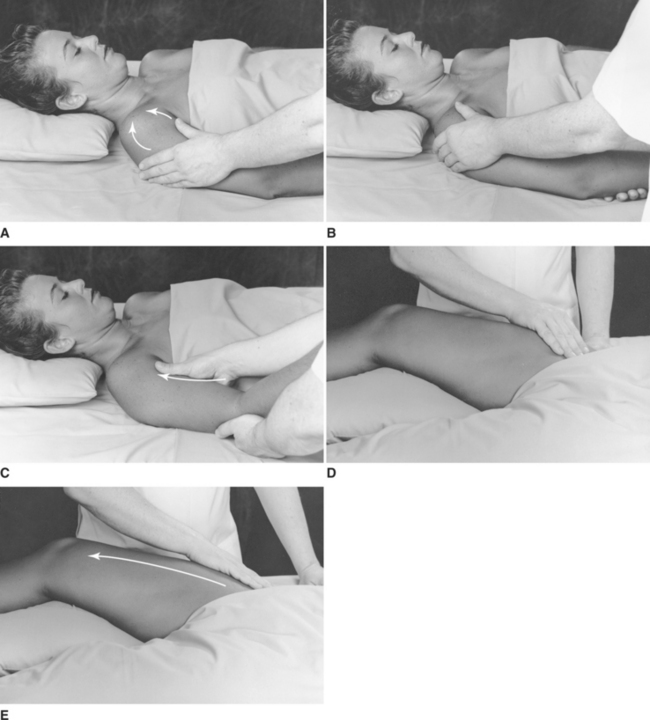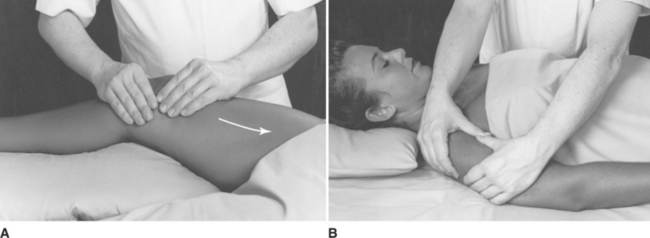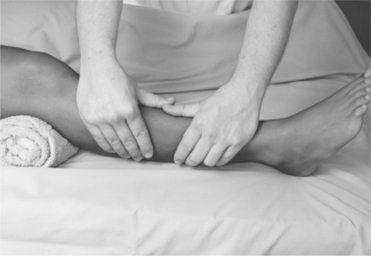Chapter 8 Local Massage Sequences
Local injury or disease can affect many different tissues, including skin, muscles, tendons, joints, nerves, blood, and lymph vessels. A therapist must have a thorough knowledge of the anatomy and physiology of the structures involved, together with an understanding of the pathological conditions in the tissues to be treated, if the treatment is to be as effective as possible. Muscles may be atrophied, decreased in tone, fibrotic, flaccid, or in spasm. Tissues may be edematous; joint effusion and inflammation may limit movement and produce pain. Adhesions and contractures may cause tendons to adhere to the surrounding structures, and the circulation may also be impaired. These problems are likely to prevent normal limb motion and therefore everyday functional abilities. Each of these potential problems must be evaluated and treated by techniques selected according to the changes present and the specific treatment goals.
Each of the individual techniques described in Chapter 4 can be used separately or in combination with each other and with many other treatment approaches. The important point is for the therapist to gain a thorough understanding of how the patient’s problems are affecting the tissues. Once this is properly understood, identifying appropriate treatment goals and choosing a suitable massage technique is relatively easy—it is simply a question of matching the needs of the tissues with the known effects of the massage technique. For example, if tendon and muscle contractures are limiting joint motion, then the mobilizing effects of kneading, wringing, picking up, and deep frictions might be helpful, especially when combined with other treatments such as exercise and appropriate electrophysical agents (EPAs). It is therefore proper for an experienced therapist to develop his or her own particular combination of massage techniques (a sequence) to be used as part of a specific treatment plan for local trauma or disease in a patient. Modern rehabilitation practice now encompasses a wide variety of treatment concepts, including many types of soft tissue manipulation. Although some of today’s treatment con-cepts have been developed over the past 50 years, other techniques have been practiced for many centuries (see Chapter 1 on the history of massage). The combination of time-honored techniques and newer ideas has significantly increased the treatment options available to both patient and therapist.
It is important to recognize that there are many different ideas about massage strokes and how they can be combined into a massage sequence, sometimes called a massage system. Many of these systems of massage were popular in the early 1900s and were effective then, as indeed they are today; however, the development of modern rehabilitation methods has produced other procedures that are more effective than massage alone. For this reason, massage is rarely used as a sole treatment today; in fact, it can be argued that massage has its most beneficial effects when it is combined with other treatments to give a more rounded approach to the management of the patient’s problem. In this regard, it is most appropriate to select suitable techniques from those detailed in Chapter 4 and combine them with any of a number of complementary techniques. This may well result in a mini-sequence of strokes, designed to achieve a particular effect, especially if it is directed to a specific anatomical structure such as a ligament or tendon. This may be termed focal massage to distinguish it from local or general massage (see Chapter 9 for examples).
The term local massage was defined in Chapter 4 as follows:
A combination of individual strokes represents a local massage sequence, and the specific strokes included in such a list can be many and varied. Based on the description and use of the individual strokes described in Chapter 4, the sequences listed in Tables 8-1 to 8-4 can be used for local massage treatments to the regions specified. The therapist can modify each list as desired and as needed to treat an individual patient. For example, a therapist could select a local sequence of techniques to treat the major muscles of a patient’s upper arm (biceps and triceps). In this case, the therapist could use all of the techniques affecting these structures.
Table 8-1 Local Massage Sequence for the Lower Limbs (I)
| PROCEDURE | DVD CHAPTER | REPETITIONS |
|---|---|---|
| Anterior Aspects (Patient in Long Sitting) | 4–38 | |
| Superficial stroking to the whole limb | 4–39 | 3 |
| Effleurage to the whole limb | 4–40 | 3 |
| Compression kneading to the thigh muscles | 4–41 | 3 |
| Picking up to the quadriceps muscles | 4–42 | 3 |
| Wringing to the medial thigh muscles | 4–43 | 3 |
| Effleurage to the whole limb | 4–40 | 3 |
| Finger pad kneading around the patella | 4–48 | 2 |
| Picking up to the calf muscles | 4–49 | 3 |
| Thumb pad kneading to the anterior tibial muscles | 4–50 | 2 |
| Finger pad kneading to the ankle region | 4–51 | 2 |
| Thumb pad kneading to the dorsum of the foot and toes | 4–52 | 2 |
| Knuckle kneading to the plantar aspects of the foot | 4–53 | 3 |
| Effleurage to the whole limb | 4–40 | 3 |
| Relaxed passive movements to the lower limb | 4–55 | 3 |
Table 8-2 Local Massage Sequence for the Lower Limbs (II)
| PROCEDURE | DVD CHAPTER | REPETITIONS |
|---|---|---|
| Posterior Aspects (Patient in Prone Lying) | 4–23 | |
| Superficial stroking to the whole limb | 4–24 | 3 |
| Effleurage to the whole limb | 4–25 | 3 |
| Compression kneading to the thigh muscles | 4–26 | 3 |
| Picking up to the hamstring muscles | 4–27 | 3 |
| Wringing to the hamstring muscles | 4–28 | 3 |
| Effleurage to the whole limb | 4–25 | 3 |
| Finger pad kneading around the knee joint regions | 4–31 | 2 |
| Compression kneading to the calf muscles | 4–32 | 3 |
| Picking up to the calf muscles | 4–33 | 3 |
| Wringing to the calf muscles | 4–34 | 3 |
| Thumb pad kneading to the calf muscles | 4–35 | 2 |
| Finger pad kneading to the ankle region | 4–36 | 2 |
| Thumb pad kneading to the plantar aspects of the foot and toes | 4–37 | 2 |
| Effleurage to the whole limb | 4–25 | 3 |
| Relaxed passive movements to the lower limb | 4–56 | 3 |
Table 8-3 Local Massage Sequence for the Upper Limbs
| PROCEDURE | DVD CHAPTER | REPETITIONS |
|---|---|---|
| All Aspects (Patient in Sitting) | 4–57 | |
| Superficial stroking to the whole limb | 4–58 | 3 |
| Effleurage to the whole limb | 4–59 | 3 |
| Compression kneading to the deltoid, biceps, and triceps muscles | 4–60 | 3 |
| Picking up to the deltoid, biceps, and triceps muscles | 4–61 | 3 |
| Wringing to the biceps and triceps | 4–62 | 3 |
| Finger pad kneading around the elbow joint | 4–63 | 2 |
| Effleurage to the whole limb | 4–58 | 3 |
| Thumb pad kneading to the wrist and finger extensors | 4–64 | 2 |
| Thumb pad kneading to the wrist and finger flexors | 4–65 | 2 |
| Thumb pad kneading to the wrist and hand | 4–66 | 2 |
| Effleurage to the whole limb | 4–58 | 3 |
| Relaxed passive movements to the upper limb | 4–68 | 3 |
Table 8-4 Local Massage Sequence for the Posterior Trunk and Pelvis
| PROCEDURE | DVD CHAPTER | REPETITIONS |
|---|---|---|
| Back (Patient in Prone Lying) | 4–1 | |
| Superficial stroking to the entire back region | 4–2 | 3 |
| Effleurage to the entire back region | 4–3 | 3 |
| Compression kneading to the posterior trunk muscles | 4–4 | 3 |
| Reinforced kneading to the lumbar region | 4–5 | 3 |
| Effleurage to the entire back region | 4–2 | 3 |
| Wringing to the muscles of the lateral body wall | 4–6 | 3 |
| Skin rolling over the posteriolateral chest wall | 4–7 | 3 |
| Circular frictions to the paraspinal muscles | 4–8 | 2 |
| Effleurage to the entire back region | 4–2 | 3 |
THE HOFFA SYSTEM
Albert Hoffa’s original work, Technic der Massage, was published in four editions, the last one in 1903 (see Chapter 1). The system developed by this eminent surgeon follows an anatomical pattern and is based on a knowledge of physiology. The movements are applied to certain muscles or muscle groups; this contrasts with some other systems that apply strokes either to an entire extremity or to a certain area of the body. Hoffa classified the essential massage strokes as effleurage (stroking), pétrissage (kneading), friction, vibration, and tapotement (percussion) and stated that these are only the framework on which an experienced therapist with good judgment may build up an effective treatment for a given patient’s problem. He emphasized the value of massage for increasing venous and lymphatic circulation. One must keep in mind, however, the context in which he developed his system and, in particular, the range of treatment options available at the time and the state of medical knowledge. (The rehabilitation professions as we currently know them did not exist at that time.)
Classification and Description of Local Massage Strokes Used in the Hoffa System
The following classification and description of massage strokes is a modification of the Hoffa system of massage as described by Gertrude Beard in the early editions of this text. In general, all of these descriptions match those defined in Chapter 4. The Hoffa system uses only a selected number of these techniques, and, of course, any appropriate combination of these techniques is possible.
Stroking (Superficial or Deep)
Note that in the Hoffa system, deep stroking is similar to effleurage.
Kneading
Single-Handed Kneading
Two-Handed Kneading
Two-Handed Digital Kneading
The therapist uses both hands (between the thumb and the index and middle fingers of each hand) to grasp the muscle at its insertion. The palmar surface of the left fingers pulls the tissues toward the therapist, while the right thumb pushes the adjacent tissues away. Then the right fingers pull the tissues while the left thumb pushes the adjacent tissues (Figure 8-3). Progression from origin to insertion is accomplished with a gliding of the fingers on the pull movement. Again, this should not be a pinching movement. The thumb and fingers of each hand are kept in the same relation to each other during the entire movement. The push and pull are accomplished chiefly by flexion and extension of the arms at the shoulders and elbows. The return stroke is performed with the fingers of the distal hand. This movement is used mainly for muscles of small to medium bulk. Care must be taken to ensure that the hands are held parallel to the length of the muscles, thereby allowing as much contact as possible. This technique produces a movement similar to the stroke called wringing; however, there is no twist in this stroke.
Modified Hoffa Technique for Local Massage
The technique of local massage described next and its application to the anatomical sections of the body are modified from the classical Hoffa system. In the application of these massage strokes to an extremity, the proximal portion should be treated first, followed by the more distal segment or segments. Then special attention may be given to areas that require additional treatment. The stroking and kneading movements may be adapted to conform to the muscles of any body area. In the beginning of treatment, stroking precedes the kneading movement, and periods of stroking and kneading should alternate according to the pathologic condition being treated, the desired effect, and the result being obtained from the massage. The final stroke should always be superficial stroking.
Local Massage Sequence (Modified Hoffa System)
Tables 8-5 to 8-8 describe local massage sequences for the lower limbs, upper limbs, posterior trunk and pelvis, and head/neck area.
Table 8-5 Local Massage Sequence for the Upper Limbs
| LIMB | FIGURE | REPETITIONS |
|---|---|---|
| Right Arm | ||
| Deltoid muscle group | 8–4 | 3 |
| Elbow extensor muscle group (triceps and anconeus) | 8–5 | 3 |
| Elbow flexor muscle group (biceps, brachialis, and coracobrachialis) | 8–6 | 3 |
| Right Forearm | ||
| Medial muscle groups | 8–7 | 3 |
| Lateral muscle groups | 8–7 | 3 |
| Right Hand | ||
| Muscles of the radial section (thenar muscles, adductor pollicis, lumbricals, and interossei) | 8–9 | 3 |
| Muscles of the ulnar section (hypothenar muscles, lumbricals, and interossei) | 8–10 | 3 |
| Palmar surface | 8–11 | 3 |
| Dorsal surface | 8–12 | 3 |
| Right Thumb and Fingers | ||
| Dorsal surface | 8–13 | 3 |
| Palmar surface | 8–14 | 3 |
| Left Arm, Forearm, and Hand | ||
| All of the previous strokes are repeated to the left upper limb | ||
Table 8-6 Local Massage Sequence for the Lower Limbs
| LIMB | FIGURE | REPETITIONS |
|---|---|---|
| Right Buttock Region | ||
| Gluteal muscles (gluteus maximus, medius, and minimus) | 8–15 | 3 |
| Right Thigh | ||
| Medial hamstring muscles (semimembranosus and semitendinosus) | 8–16 | 3 |
| Lateral hamstring muscle (biceps femoris) | 8–17 | 3 |
| Tensor of the fascia lata (including the iliotibial tract/band) | 8–18 | 3 |
| Anterior thigh group (rectus femoris, vastus medialis, vastus intermedius, vastus lateralis, and articularis genu sartorius) | 8–19 | 3 |
| Adductor muscle group (adductor, longus, adductor magnus, and gracilis) | 8–20 | 3 |
| Right Leg | ||
| Anterior tibial muscles (tibialis anterior, extensor digitorum longus, extensor hallucis longus, and fibularis/peroneus tertius) | 8–21 | 3 |
| Fibularis (peroneal) muscles (fibularis longus and fibularis brevis) | 8–22 | 3 |
| Calf muscles (gastrocnemius, soleus, and plantaris) | 8–23 | 3 |
| Right Foot* | ||
| Medial section | 8–24 | 3 |
| Lateral section | 8–25 | 3 |
| Dorsal section | 8–26 | 3 |
| Plantar section | 8–27 | 3 |
| Right Toes | — | 3 |
| Left Buttock, Thigh, Leg, and Foot | ||
| All of the previous strokes are repeated on the left lower limb | — | |
Stay updated, free articles. Join our Telegram channel

Full access? Get Clinical Tree










